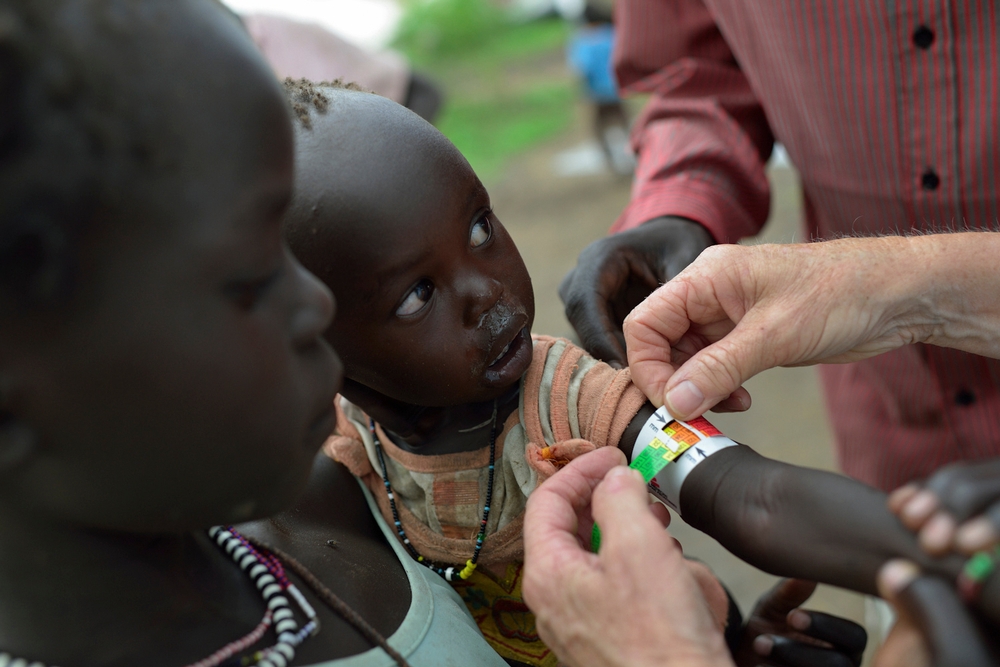Archive for the ‘Malnutrition’ Category
Egypt: One in five children are stunted or too short for their age
Sunday, May 12th, 2019WASTING STUNTING UNDERWEIGHT
Low weight for height Low height for age Low weight for age
In Egypt, despite the investment in the health sector, and a notable decline in child mortality, malnutrition rates remain high.

For young children under five years of age:
• Stunting remains a significant public health concern in Egypt, affecting 1 in 5 children
• Wasting has increased significantly since 2000, and the trend is significantly higher among girls
• Wasting and underweight stand at 8 and 6 percent, respectively
• The incidence of anemia is high, standing at 27 percent
Stunting is a measure of chronic malnutrition; it reflects inadequate nutrition over a long period, or effects of recurrent or chronic illnesses. The stunting rate of children under five is the percentage whose height-for-age is below minus 2 standard deviations (moderate and severe stunting) from the median heightfor-age.
Underweight reflects both acute and chronic malnutrition. The underweight rate for children under-five is the percentage of whose weight-for-age is below minus 2 standard deviations (moderate) and minus 3 standard deviations (underweight) from the median weightfor-age.
Wasting is a measure of current acute malnutrition, which may reflect acute food shortage or recent episodes of illness. The wasting rate is the percentage of children under-five whose weightfor-height is below minus 2 standard deviations (moderate) and minus 3 standard deviations (severe) from the median weight-for-height.
Overweight is defined as excessive fat accumulation that may impair health. The overweight rate among children under five is the percentage whose weight-forheight is above plus 2 standard deviations from the median weight-for-age. Among adolescents and adults, it is the percentage of individuals with a Body Mass Index equal or higher than 25.
The United Nations: 13 million people in Yemen are facing starvation.
Wednesday, October 17th, 2018Venezuela: Doctors at 21 public hospitals in 17 states across the country said that their ERs were being overwhelmed by children with severe malnutrition
Thursday, December 21st, 2017MSF on Malnutrition
Wednesday, October 4th, 2017Eight children die every minute because their diet lacks essential nutrients. They will continue to do so unless food aid changes.
MSF admitted 181,600 malnourished children to inpatient or outpatient feeding programs in 2015.
When children suffer from acute malnutrition, their immune systems are so impaired that the risk of death is greatly increased. According to the World Health Organization (WHO), malnutrition is the single greatest threat to the world’s public health.
The critical age for malnutrition is from six months—when mothers generally start supplementing breast milk—to 24 months. However, children under five, adolescents, pregnant or breastfeeding women, the elderly, and the chronically ill are also vulnerable.
People become malnourished if they are unable to take in enough or fully utilize the food they eat, due to illnesses such as diarrhea or other longstanding illnesses, such as measles, HIV, and tuberculosis.
We estimate that only three percent of the 20 million children suffering from severe acute malnutrition receive the lifesaving treatment they need.
What Causes Malnutrition?
Facts
Breast milk is the only food a child needs for its first six months. Beyond this point, breastfeeding alone is not sufficient.
Diets at this stage must provide the right blend of high-quality protein, essential fats and carbohydrates, vitamins, and minerals.
In the Sahel, the Horn of Africa, and parts of South Asia, highly nutritious foods such as milk, meats, and fish are severely lacking.
For a child under the age of two, their diet will have a profound impact on their physical and mental development. Malnourished children under the age of five have severely weakened immune systems and are less resistant to common childhood diseases.
This is why a common cold or a bout of diarrhea can kill a malnourished child. Of the seven million deaths of children under five years of age each year, malnutrition contributes to at least one-third.
Symptoms of Malnutrition
Understandably, the most common sign of malnutrition is weight loss. Loss of weight may also be accompanied by a lack of strength and energy and the inability to undertake routine tasks. Those who are malnourished often develop anemia and therefore exhibit a lack of energy and breathlessness.
In children, signs of malnutrition may include an inability to concentrate or increased irritability, and stunted growth. In cases of severe acute malnutrition, swelling of the stomach, face, and legs, and changes in skin pigmentation may also occur.
Diagnosing Malnutrition
Malnutrition is diagnosed by comparing standard weights and heights within a given population, or by the measurement of a child’s mid-upper arm circumference (MUAC).
If dietary deficiencies are persistent, children will stop growing and become ‘stunted’—meaning they have a low height for their age. This is diagnosed as chronic malnutrition.
If they experience weight loss or ‘wasting’—low weight for one’s height—they are diagnosed as suffering from acute malnutrition.
This occurs when a malnourished person begins to consume his or her own body tissues to obtain needed nutrients.
In the severe acute form, children with kwashiorkor—distended stomachs—can be clinically diagnosed with body swelling, irritability, and changes in skin pigmentation.

Treating malnutrition
We believe that ready-to-use therapeutic food (RUTF) is the most effective way to treat malnutrition. RUTFs include all the nutrients a child needs during its development and helps reverse deficiencies and gain weight. RUTFs don’t require water for preparation, which eliminates the risk of contamination with water-borne diseases.
Because of its packaging, RUTFs can be used in all kinds of settings and can be stored for long periods of time. Unless the patient suffers from severe complications, RUTFs also allow patients to be treated at home.
Where malnutrition is likely to become severe, Doctors Without Borders/Médecins Sans Frontières (MSF) takes a preventative approach by distributing supplementary RUTF to at-risk children.
In 2015, MSF admitted 181,600 malnourished children into feeding programs.
World Vision: More than 800,000 children risk death by starvation in East Africa and aid agencies have just weeks – months at most – to save them
Saturday, September 30th, 2017- World Vision – the world’s largest international children’s charity
- “We’re seeing emaciated children, nearly skeletons, lying in pain in hospital beds … We’re seeing mothers unable to breastfeed because they are malnourished themselves.”
- “The hunger crisis is wreaking havoc on 24 million people (in East Africa) – more than the population of Berlin, London, Chicago and Bangkok combined.”








